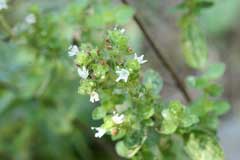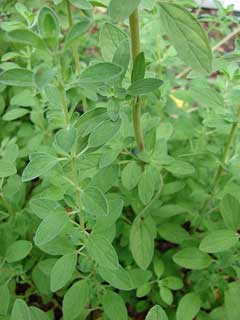 |
|
http://commons.wikimedia.org/wiki/User:Sten |
 |
| http://www.hear.org/starr/ |
Translate this page:
Summary
Oregano is a densely growing plant for sunny positions; it makes a good ground cover despite being slow to spread. An excellent flavouring for cooked foods and salads, it is an ideal companion plant and is said to repel insect pests. The subspecies O. vulgare hirtum comes from Greece and is more aromatic. Harvest stems after three months once the plant is established. Two other Origanum species with tasty leaves worth considering are Sweet Marjoram (O. Majorana), native to Cyprus and Turkey, and Pot Marjoram (O. onites), native to Turkey, Greece and Italy (Sicilia). Pot Marjoram leaves, with a robust thyme-like aroma, are used as a substitute for Oregano or Marjoram but are inferior in flavour. They are slightly bitter and not nearly as sweet and delicate as Sweet Marjoram or Oregano, but the flavour lasts longer in cooked dishes.
Harvesting: Harvest leaves from the first year all year, but they are best in late spring to summer, just before the plant begins to flower.
Physical Characteristics

 Origanum majorana is a PERENNIAL growing to 0.6 m (2ft) by 0.6 m (2ft in) at a fast rate.
Origanum majorana is a PERENNIAL growing to 0.6 m (2ft) by 0.6 m (2ft in) at a fast rate.
See above for USDA hardiness. It is hardy to UK zone 7. It is in flower from June to September, and the seeds ripen from August to September. The species is hermaphrodite (has both male and female organs) and is pollinated by Bees. The plant is self-fertile.
It is noted for attracting wildlife.
Suitable for: light (sandy), medium (loamy) and heavy (clay) soils and prefers well-drained soil. Suitable pH: mildly acid, neutral and basic (mildly alkaline) soils. It can grow in semi-shade (light woodland) or no shade. It prefers dry or moist soil.
UK Hardiness Map
US Hardiness Map
Synonyms
O. majoranoides. Majorana hortensis.
Plant Habitats
Cultivated Beds;
Edible Uses
Edible Parts: Leaves
Edible Uses: Condiment Tea
Leaves - raw or cooked[2, 52]. Sweet marjoram is widely used as a flavouring for salad dressings, vegetables, legumes and oils[7, 14, 27, 61, 171, 238]. It has a more delicate flavour than the closely related oregano (Origanum vulgare), and is best when used fresh and only added towards the end of cooking[238]. The aromatic seeds are used as a flavouring in sweets, drinks etc[183]. A herb tea is made from the fresh or dried leaves[21, 183]. The flavour resembles a blend of thyme, rosemary and sage[183].
References More on Edible Uses
Medicinal Uses
Plants For A Future can not take any responsibility for any adverse effects from the use of plants. Always seek advice from a professional before using a plant medicinally.
Antidepressant Antiseptic Antispasmodic Aromatherapy Carminative Cholagogue Diaphoretic Disinfectant
Emmenagogue Expectorant Stimulant Stomachic Tonic
Sweet marjoram is mainly used as a culinary herb, but is also medicinally valuable due to its stimulant and antispasmodic properties[254]. It is a good general tonic, treating various disorders of the digestive and respiratory systems. It has a stronger affect on the nervous system than the related oregano (O. vulgare) and is also thought to lower the sex drive[254]. Because it can promote menstruation, it should not be used medicinally by pregnant women though small quantities used for culinary purposes are safe[254]. The herb is antiseptic, antispasmodic, carminative, cholagogue, diaphoretic, diuretic, emmenagogue, expectorant, stimulant, stomachic and mildly tonic[4, 7, 21, 240]. It is taken internally in the treatment of bronchial complaints, tension headaches, insomnia, anxiety, minor digestive upsets and painful menstruation[238]. It should not be prescribed for pregnant women[238]. Externally, it is used to treat muscular pain, bronchial complaints, arthritis, sprains and stiff joints[238]. The plant is harvested as flowering begins and can be used fresh or dried. Marjoram is often used medicinally in the form of the essential oil, about 400 grams being obtained from 70 kilos of the fresh herb[4]. The oil is used as an external application for sprains, bruises etc[4, 240]. The essential oil is used in aromatherapy. Its keyword is 'Muscle relaxant'[210].
References More on Medicinal Uses
The Bookshop: Edible Plant Books
Our Latest books on Perennial Plants For Food Forests and Permaculture Gardens in paperback or digital formats.

Edible Tropical Plants
Food Forest Plants for Hotter Conditions: 250+ Plants For Tropical Food Forests & Permaculture Gardens.
More

Edible Temperate Plants
Plants for Your Food Forest: 500 Plants for Temperate Food Forests & Permaculture Gardens.
More

More Books
PFAF have eight books available in paperback and digital formats. Browse the shop for more information.
Shop Now
Other Uses
Disinfectant Dye Essential
Agroforestry uses: Oregano can be used as a companion plant, helping to attract beneficial insects and improving the overall health of surrounding plants. It may also help deter certain pests. The leaves and flowers yield 0.3 - 0.4% essential oil by steam distillation[240]. Called 'Oil of Sweet Marjoram', it is used as a food flavouring and in perfumery, soaps, hair products etc[57, 61, 171, 238]. The plant is often used to disinfect bee hives[7]. 1. Nectary - Flowers rich in nectar and pollen:
Yes, Oregano produces small flowers rich in nectar, which attract various pollinators, such as bees and butterflies.
2. Wildlife - Food (Fruit, Seeds, Leaf litter, Shelter, Nesting, Roosting):
Yes—While oregano does not produce significant fruit or seeds, its leaves are edible and nutritious for humans and can provide some food value for wildlife. Its dense foliage can also offer shelter, although it is not typically used for nesting.
3. Invertebrate Shelter (Overwintering sites, Leaf litter, Groundcover):
Yes – Oregano can provide a habitat for beneficial insects and contribute to ground cover. Its structure may support some invertebrates, and leaf litter can provide overwintering sites for various organisms.
4. Pest Confuser (Smell):
Yes – Oregano has a strong aromatic scent that can help confuse or deter some pests, making it beneficial in companion planting scenarios.
Special Uses
Attracts Wildlife Food Forest Scented Plants
References More on Other Uses
Cultivation details
Requires a rather dry, warm, well-drained soil, but is not fussy as to soil type[18], thriving on chalk[1, 37]. Prefers slightly alkaline conditions[200]. Sweet marjoram is often cultivated as a culinary herb, there are some named varieties[46, 183]. Plants do not normally survive the winter outdoors in Britain so they are usually grown as an annual[1, 4, 14, 37]. Another report says that it is possible to overwinter plants in areas with cold winters so long as you apply a thick mulch to the roots[200]. Container growing is preferred in areas with cold, wet winters or humid, wet summers. Plants do not often set seed in Britain[K]. A good companion plant, improving the flavour of nearby plants[14, 18, 20]. The flowers are very attractive to bees[108]. The bruised leaves emit a fragrance somewhat resembling thyme, but somewhat sweeter with balsamic undertones[245]. This is a sacred plant in India[171]. Members of this genus are rarely if ever troubled by browsing deer[233]. In garden design, as well as the above-ground architecture of a plant, root structure considerations help in choosing plants that work together for their optimal soil requirements including nutrients and water. The root pattern is rhizomatous with underground stems sending roots and shoots along their length [2-1]. Oregano is self-fertile. Oregano is typically harvested in late spring to summer, just before the plant begins to flower.
Oregano generally flowers from mid-summer to early autumn. Oregano grows relatively quickly, reaching maturity in about 2-3 months under optimal conditions.
References Carbon Farming Information and Carbon Sequestration Information
Temperature Converter
Type a value in the Celsius field to convert the value to Fahrenheit:
Fahrenheit:
The PFAF Bookshop
Plants For A Future have a number of books available in paperback and digital form. Book titles include Edible Plants, Edible Perennials, Edible Trees,Edible Shrubs, Woodland Gardening, and Temperate Food Forest Plants. Our new book is Food Forest Plants For Hotter Conditions (Tropical and Sub-Tropical).
Shop Now
Plant Propagation
Seed - sow early spring at 10 - 13°c and only just cover the seed. Germination usually takes place within 2 - 4 weeks. Prick out the seedlings into individual pots when they are large enough to handle and plant them out into their permanent positions in early summer. The seed can also be sown in situ in April or early May and, although it can be slow to germinate, usually does well[4]. Division in March or October. Very easy, larger divisions can be planted out direct into their permanent positions. We have found that it is better to pot up the smaller divisions and grow them on in light shade in a cold frame until they are well established before planting them out in late spring or early summer. Basal cuttings of young barren shoots in June. Very easy. Harvest the shoots with plenty of underground stem when they are about 8 - 10cm above the ground. Pot them up into individual pots and keep them in light shade in a cold frame or greenhouse until they are rooting well. Plant them out in the summer.
Other Names
If available other names are mentioned here
Native Range
TEMPERATE ASIA: Turkey (south),Cyprus.
Weed Potential
Right plant wrong place. We are currently updating this section.
Please note that a plant may be invasive in one area but may not in your area so it's worth checking.
Conservation Status
IUCN Red List of Threatened Plants Status :

Growth: S = slow M = medium F = fast. Soil: L = light (sandy) M = medium H = heavy (clay). pH: A = acid N = neutral B = basic (alkaline). Shade: F = full shade S = semi-shade N = no shade. Moisture: D = dry M = Moist We = wet Wa = water.
Now available:
Food Forest Plants for Mediterranean Conditions
350+ Perennial Plants For Mediterranean and Drier Food Forests and Permaculture Gardens.
[Paperback and eBook]
This is the third in Plants For A Future's series of plant guides for food forests tailored to
specific climate zones. Following volumes on temperate and tropical ecosystems, this book focuses
on species suited to Mediterranean conditions—regions with hot, dry summers and cool, wet winters,
often facing the added challenge of climate change.
Read More
Expert comment
Author
L.
Botanical References
93200
Links / References
For a list of references used on this page please go here
Readers comment